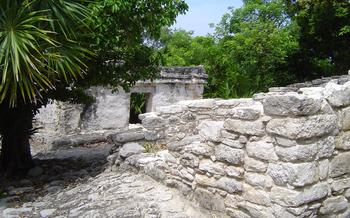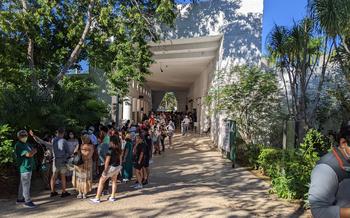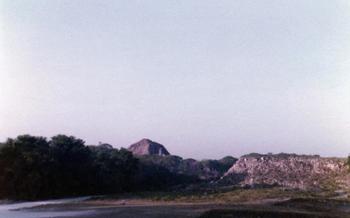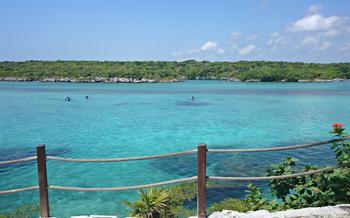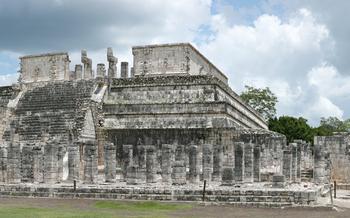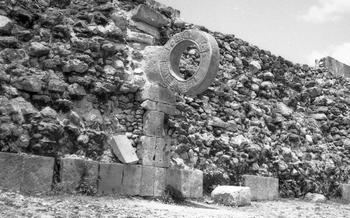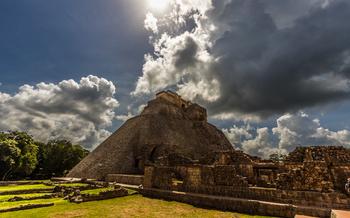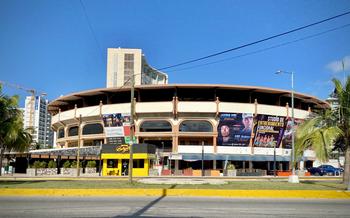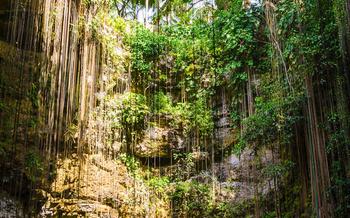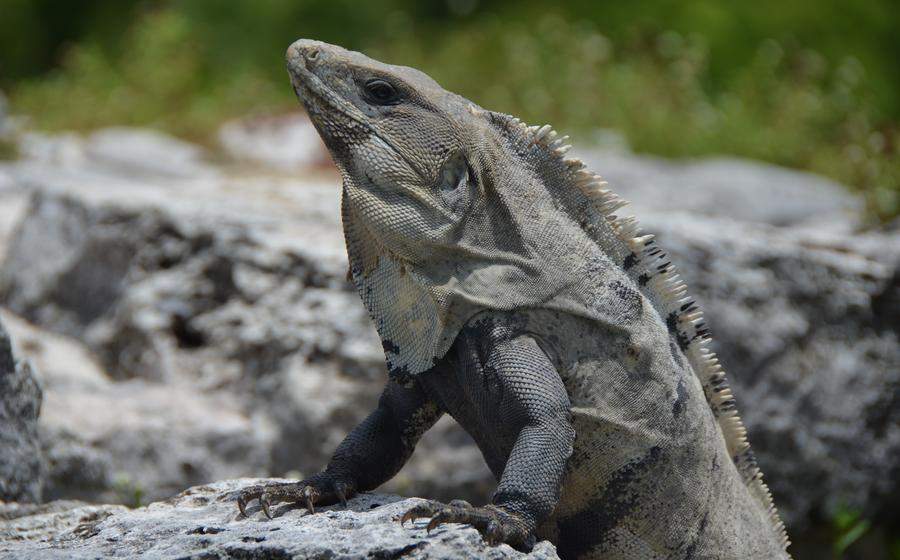
El Rey Archaeological Zone
- El Rey Ruins: A Mayan Gem in Cancun's Backyard
- Unveiling the Ancient City: A Journey Through Time
- Exploring the Ruins: A Step-by-Step Guide
- Temple of the Frescoes: A Masterpiece of Mayan Art
- The Ball Court: Where Ritual and Competition Converge
- Plaza Oeste: The Heart of the Ancient City
- El Rey's Hidden Cenote: A Refreshing Surprise
- Tips for a Memorable Visit: Making the Most of Your Time
- Unveiling the History: A Glimpse into the Maya Civilization
- Sustainability and Preservation: Protecting El Rey for Future Generations
- Local Culture and Cuisine: Embracing the Flavors of Cancun
- Beyond El Rey: Discovering Cancun's Other Treasures
- When to Visit El Rey: Finding the Best Time
- Getting to El Rey: Transportation Options
- Insider Tip: Discovering Hidden Gems Off the Beaten Path
El Rey Ruins: A Mayan Gem in Cancun's Backyard
In the heart of the bustling hotel zone of Cancun, nestled amidst lush greenery and vibrant turquoise waters, lies a hidden treasure—the El Rey Archaeological Zone. This ancient Mayan city, dating back to the Late Classic period (600-900 AD), offers a glimpse into the rich history and cultural heritage of the Maya civilization. The site, comprising over 40 structures, including temples, plazas, and residential areas, is a testament to the architectural prowess and sophisticated urban planning of the Maya people.
El Rey's strategic location, just a short distance from the modern city of Cancun, makes it easily accessible to visitors seeking a unique blend of history, culture, and natural beauty. As you step through the gates of the archaeological zone, you'll be transported back in time, surrounded by the remnants of a once-thriving Mayan community. The site's proximity to the hotel zone allows for a convenient day trip, offering a welcome respite from the lively tourist hub.
Unveiling the Ancient City: A Journey Through Time
The discovery of the El Rey ruins is a captivating tale that transports us back to a time when the Maya civilization thrived in this region. In the 1970s, as Cancun began to develop as a tourist destination, construction workers stumbled upon ancient artifacts while clearing land for a new hotel. Intrigued by these findings, archaeologists were called in to investigate, and their excavations revealed a hidden treasure trove of Maya ruins.
El Rey emerged as a significant archaeological site, shedding light on the daily life and rituals of the ancient Maya people. Through careful study of the ruins, archaeologists have pieced together a vivid picture of a bustling city, where people went about their daily lives, engaged in religious ceremonies, and traded with neighboring communities. The discovery of El Rey has provided invaluable insights into the rich cultural heritage of the Maya civilization.
One of the most striking aspects of El Rey is its unique architectural style. The buildings showcase intricate carvings, elaborate sculptures, and distinctive corbelled arches, which are a hallmark of Maya architecture. The ruins reveal a sophisticated understanding of engineering and construction techniques, demonstrating the advanced skills of the Maya builders. These architectural marvels serve as a testament to the ingenuity and creativity of this ancient civilization.
Furthermore, El Rey played a crucial role in the Maya trade network. Its strategic location along the coast allowed for easy access to both land and sea trade routes. Through these connections, the Maya people exchanged goods, ideas, and technologies with other Maya cities and regions, fostering cultural exchange and economic growth. El Rey's position as a trading hub contributed to its prosperity and influence within the Maya world.
Exploring the Ruins: A Step-by-Step Guide
Planning Your Visit:
Before embarking on your journey to the El Rey ruins, it's essential to plan your visit to make the most of your time. Choose the best time to go, typically during the early morning or late afternoon to avoid the scorching midday sun. Check the entrance fees and operating hours to ensure a seamless visit.
Must-See Structures:
As you enter the archaeological zone, you'll be greeted by a series of impressive structures that showcase the architectural prowess of the Maya. The Temple of the Frescoes, with its vibrant murals depicting scenes from Maya mythology, is a must-see. The Ball Court, where the ancient Maya played their sacred ball game, offers a glimpse into their rituals and athleticism.
Navigating the Site:
To enhance your exploration, consider obtaining a map of the site from the ticket office. Guided tours are available for those who prefer a more in-depth understanding of the ruins and their history. However, self-exploration allows you to wander at your own pace and discover hidden corners of the ancient city.
Respecting the Heritage:
As you explore the El Rey ruins, remember that you're walking on sacred ground that holds immense cultural significance for the Maya people. Respect the ruins by refraining from touching or climbing on the structures. Help preserve this invaluable heritage by avoiding littering and following the designated pathways.
Temple of the Frescoes: A Masterpiece of Mayan Art
The Temple of the Frescoes stands as a testament to the artistic prowess and cultural significance of the ancient Maya civilization. This remarkably preserved temple is adorned with vibrant murals that depict scenes from Maya mythology, history, and religious beliefs. The vivid colors and intricate details of these frescoes offer a glimpse into the minds and hearts of the Maya people.
Archaeologists believe that the Temple of the Frescoes was once used for religious ceremonies and rituals. The murals depict various Maya deities, including the rain god Chaac, the maize god Yum Kaax, and the death god Ah Puch. These images provide valuable insights into the Maya pantheon and their beliefs about the afterlife.
The Temple of the Frescoes is not only a masterpiece of art but also a significant archaeological site. The murals have been carefully studied by scholars, providing valuable information about Maya culture and history. Conservation efforts are underway to protect and preserve these delicate artworks for future generations to appreciate.
Visitors to the El Rey Archaeological Zone should not miss the opportunity to explore the Temple of the Frescoes. This awe-inspiring temple offers a unique glimpse into the artistic and cultural legacy of the ancient Maya civilization.
The Ball Court: Where Ritual and Competition Converge
The ball game, known as Pok-ta-Pok, held a profound significance in Maya culture, representing a sacred ritual deeply intertwined with their religious beliefs and social structure. The El Rey archaeological zone boasts an impressive ball court, a testament to the importance of this ancient sport. Measuring approximately 60 meters in length and 15 meters in width, the ball court features two parallel stone walls with sloped sides and stone rings fixed high on each wall. These rings, known as "hoops," served as targets for the players to aim their rubber ball through.
Beyond its sporting aspect, the ball game carried deep symbolic and ritualistic meanings. The Maya believed that the game represented the cosmic struggle between opposing forces, such as day and night, life and death. The outcome of the game was seen as a portent of future events, and the players were often adorned with elaborate costumes and protective gear, reflecting the sacred nature of the contest.
Offerings and ceremonies played an integral role in the ball game. Before a match, players and spectators would make offerings to the gods, seeking their favor and guidance. The game itself was accompanied by music, chanting, and dancing, creating a highly charged atmosphere. The victorious team was celebrated and honored, while the losing team might face consequences ranging from ritual sacrifice to banishment.
The ball court at El Rey also served as a gathering place for the community, beyond its function as a sporting arena. It was a venue for social interaction, entertainment, and the exchange of goods and ideas. The presence of the ball court within the El Rey ruins highlights the central role that the game played in Maya society, both as a ritualistic practice and as a form of communal entertainment.
Plaza Oeste: The Heart of the Ancient City
The central plaza, known as Plaza Oeste, held immense significance in the urban planning of the ancient Maya city. This expansive open area served as the heart of the community, hosting a variety of activities and playing a crucial role in the daily lives of its inhabitants.
Surrounding Plaza Oeste stood an array of significant structures, including temples and platforms. These buildings served both religious and administrative purposes, with temples dedicated to Maya deities and platforms used for public gatherings and ceremonies.
The plaza was a bustling hub of activity, where people from all walks of life converged. Markets were held regularly, offering an array of goods for trade, including food, pottery, and textiles. The plaza also served as a venue for social gatherings, where community members could socialize, share stories, and celebrate important occasions.
Plaza Oeste showcased the ingenuity and engineering prowess of the Maya. The plaza's layout was carefully designed to facilitate efficient movement and accommodate large gatherings. The surrounding structures exhibited intricate architectural details and impressive construction techniques, reflecting the advanced skills of the Maya builders.
Today, Plaza Oeste stands as a testament to the Maya civilization's urban planning expertise and their ability to create harmonious and functional spaces. Visitors to El Rey can wander through the plaza, marveling at the remnants of ancient structures and imagining the vibrant atmosphere that once filled this central gathering place.
El Rey's Hidden Cenote: A Refreshing Surprise
During your exploration of the El Rey Archaeological Zone, you'll stumble upon a hidden gem—a cenote nestled within the ancient city's heart. This natural wonder, known for its crystal-clear waters and refreshing ambiance, adds a unique dimension to your visit.
In Maya culture, cenotes held immense significance, serving as both water sources and sacred sites. The El Rey cenote, with its pristine waters and secluded location, offers a glimpse into this sacred relationship.
Take a dip in the cenote's refreshing waters, marveling at its depth and clarity. Snorkeling enthusiasts can explore the underwater world, discovering hidden crevices and diverse aquatic life. The cenote provides a welcome respite from the tropical heat and an opportunity to connect with the Maya's reverence for nature.
Whether you choose to swim, snorkel, or simply relax on its shores, the El Rey cenote offers a tranquil oasis, inviting you to immerse yourself in the beauty and serenity of the ancient Maya world.
Tips for a Memorable Visit: Making the Most of Your Time
To fully appreciate the beauty and history of the El Rey ruins, it's recommended to set aside at least two to three hours for your visit. This will give you ample time to explore the main structures, admire the artwork, and soak in the atmosphere of the ancient city.
When packing for your visit, be sure to wear comfortable shoes as you'll be doing a fair amount of walking. The ground can be uneven in places, so sturdy footwear is essential. Don't forget to bring sunscreen, sunglasses, and a hat to protect yourself from the sun. And of course, bring plenty of water to stay hydrated, especially if you're visiting during the warmer months.
Photography enthusiasts will want to bring their cameras to capture the stunning beauty of the ruins. The vibrant colors of the murals, the intricate carvings on the buildings, and the lush surrounding jungle provide ample opportunities for amazing shots. Just be sure to respect the rules and regulations regarding photography at the site.
Finally, it's important to be respectful of the local culture and customs when visiting the El Rey ruins. Dress modestly and avoid wearing revealing clothing. Be mindful of your behavior and avoid making loud noises or disturbing other visitors. By following these simple guidelines, you can help preserve the cultural heritage of this sacred site and ensure that future generations can enjoy it as well.
Unveiling the History: A Glimpse into the Maya Civilization
The El Rey Archaeological Zone offers a unique opportunity to delve into the rich history of the Maya civilization. Originating in the Yucatán Peninsula, the Maya flourished for over 3,000 years, leaving behind a legacy of cultural achievements that continue to captivate the world.
El Rey played a significant role in this ancient civilization, serving as a vital trading hub and a center for religious and cultural activities. Archaeological discoveries at the site have shed light on Maya customs and beliefs, including their sophisticated understanding of astronomy, mathematics, and hieroglyphic writing. The ruins provide a glimpse into their daily lives, from their intricate rituals to their agricultural practices.
The Maya civilization's influence extends far beyond the El Rey ruins. Their legacy can be seen in modern-day language, cuisine, and traditions throughout Mexico and Central America. The vibrant colors, intricate designs, and profound symbolism found in Maya art and architecture continue to inspire contemporary artists and designers.
El Rey stands as a testament to the ingenuity, resilience, and cultural richness of the Maya civilization. By exploring these ancient ruins, visitors can gain a deeper appreciation for the enduring legacy of this remarkable people.
Sustainability and Preservation: Protecting El Rey for Future Generations
El Rey Archaeological Zone stands as a testament to the rich cultural heritage of the Maya civilization. However, the preservation of this ancient site is crucial for ensuring its legacy for future generations. Sustainable tourism practices are paramount to minimize the impact on the ruins and their natural surroundings. Conservation efforts by archaeologists, historians, and local authorities aim to protect the delicate structures, restore damaged areas, and conduct ongoing research to deepen our understanding of Maya history. Educating visitors about the significance of the site and the need for its protection is essential. By promoting responsible tourism and encouraging visitors to respect the fragile ecosystem, we can collectively contribute to the preservation of this invaluable cultural treasure.
Local Culture and Cuisine: Embracing the Flavors of Cancun
El Rey Archaeological Zone offers a unique opportunity to immerse yourself in the rich culture and cuisine of Cancun. After exploring the ancient ruins, take a culinary journey by visiting the local markets and restaurants near the site. Indulge in traditional Maya dishes such as cochinita pibil (slow-roasted pork), panuchos (fried tortillas topped with beans, meat, and vegetables), and salbutes (fried tortillas with shredded turkey or chicken).
Cancun's culinary scene is a vibrant blend of Maya, Mexican, and international flavors. Discover the city's best local food experiences by venturing off the beaten path and seeking out authentic restaurants frequented by locals. Enjoy fresh seafood, tropical fruits, and flavorful spices that reflect the region's rich culinary heritage. Whether you prefer fine dining or casual street food, Cancun has something to satisfy every palate.
Beyond El Rey: Discovering Cancun's Other Treasures
While El Rey is a must-visit for history buffs, Cancun offers a wealth of other attractions to satisfy every traveler's interest. For those seeking further archaeological exploration, San Miguelito and Yamil Lu'um are two other significant Maya sites within Cancun's boundaries. These ruins provide a glimpse into the region's rich cultural heritage, with ancient structures, plazas, and artifacts waiting to be discovered.
Beyond history, Cancun boasts a diverse range of natural wonders. The city's stunning beaches, with their white sands and turquoise waters, are a haven for sun seekers, swimmers, and water sports enthusiasts. Take a refreshing dip in one of the many cenotes scattered throughout the region, where you can snorkel or dive amidst crystal-clear waters and admire the unique underwater formations. Nature lovers can explore Cancun's lush parks, such as Parque Nacional Costa Occidental de Isla Mujeres, Punta Cancun, and Parque Kabah, which offer hiking trails, wildlife spotting opportunities, and breathtaking views.
For a taste of local culture, immerse yourself in Cancun's vibrant art scene. Visit the Museo Maya de Cancun, which houses an extensive collection of Maya artifacts and exhibits, or explore the city's many art galleries, showcasing the works of local and international artists. Traditional dance performances, such as the folkloric ballet, are a captivating way to experience the region's rich cultural heritage and vibrant traditions.
To make the most of your time in Cancun, consider crafting an itinerary that combines historical exploration, natural wonders, and cultural immersion. Whether you prefer lounging on pristine beaches, snorkeling in crystal-clear cenotes, or delving into the depths of Maya history, Cancun has something to offer every traveler. Embrace the city's diverse attractions and create an unforgettable vacation experience that extends beyond the confines of El Rey.
When to Visit El Rey: Finding the Best Time
The best time to visit El Rey Archaeological Zone, and Cancun in general, is during the shoulder seasons, which fall between April and May and September and October. During these months, the weather is still pleasant, with warm temperatures and plenty of sunshine, but the crowds are smaller, making for a more relaxed and enjoyable experience.
The hottest and most humid months in Cancun are July and August, and these months also see the most rainfall. While it is still possible to visit El Rey during this time, be prepared for hot and sticky conditions and the possibility of rain.
The winter months, from November to March, are generally mild and dry, making them a popular time to visit Cancun. However, these months also see the largest crowds, as many people from colder climates escape to Cancun to enjoy the warm weather.
If you are looking to avoid the crowds and get the best possible experience at El Rey, aim to visit during the shoulder seasons. You'll still have plenty of warm weather to enjoy, but you'll be able to explore the ruins without the throngs of tourists.
Getting to El Rey: Transportation Options
Reaching El Rey Archaeological Zone requires a convenient and efficient transportation plan.
-
Distance from Key Locations: El Rey is situated just 15 kilometers (9 miles) from Cancun's Hotel Zone, making it an easily accessible day trip. From Playa del Carmen, the distance is approximately 60 kilometers (37 miles).
-
Public Transportation: Public buses run regularly from Cancun's city center and the Hotel Zone to the El Rey ruins. These buses are affordable and reliable, but they may require some patience and local knowledge to navigate. Taxis and colectivos (shared vans) are also available, offering a more direct and comfortable option at a slightly higher cost.
-
Renting a Car: For those seeking independence and flexibility, renting a car is an excellent choice. The roads in Cancun and the surrounding area are well-maintained, making it easy to drive. Ample parking is available near the archaeological zone, ensuring a hassle-free visit.
-
Private Driver: Travelers who prefer a more personalized experience can opt for a private driver or guided tour. This option allows for customized itineraries, including stops at other attractions along the way. It also eliminates the need for navigation and provides valuable insights from local experts.
Insider Tip: Discovering Hidden Gems Off the Beaten Path
Beyond the well-trodden paths of El Rey, there's a world of hidden gems waiting to be discovered. For those willing to venture off the beaten track, the rewards are immense. Within the archaeological zone itself, seek out secluded temples nestled amidst the lush vegetation, offering breathtaking panoramic views of the surrounding landscape. Explore lesser-known archaeological sites in the vicinity, such as San Miguelito or Yamil Lu'um, which offer a more intimate glimpse into the Maya past.
Straying from the tourist crowds, you'll find pristine beaches and secluded cenotes that offer a tranquil escape from the hustle and bustle. Ask locals for their recommendations on hidden culinary gems, where you can savor authentic Maya dishes and immerse yourself in the vibrant flavors of the region. With a little exploration and an open mind, you'll uncover the true essence of Cancun, a place where history, nature, and culture intertwine to create a tapestry of unforgettable experiences.
